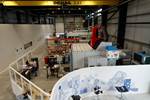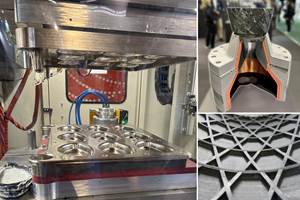LG Hausys invests in HP-RTM machine from KraussMaffei
The machine is producing advanced structural components for the visible part of automobiles, including a CFRP roof panel.
LG Hausys Ltd. (Seoul, Korea) has invested in an HP-RTM system from KraussMaffei (Munich, Germany) to produce advanced visible components made of carbon-fiber-reinforced plastics (CFRP).
"With KraussMaffei, we have a highly skilled, experienced partner at our side that has supported us from project engineering, development and prototyping all the way to series production," states Minhee Lee, vice president at LG Hausys. Since the middle of 2015, the HP-RTM metering machine has been operating at LG Hausys on a press from partner Dieffenbacher to produce advanced structural components for the visible part of automobiles, including a CFRP roof panel.
At the heart of the HP-RTM system is the RimStar Compact 8/4/8 metering system from KraussMaffei. Its main features are its accurate temperature control concept and its precise metering of release agent; it is suitable for processing both polyurethane and epoxy as a matrix material. Two mixing heads of the type MK 10-2K-RTM are used. These prove their value through high durability and exact material discharge, even when there are pressure changes in the mold. "That's how we provide our customer with maximum flexibility and guarantee a constantly high level of component quality," said Wolfgang Hinz, product and sales manager at KraussMaffei.
The HP-RTM system delivered to LG Hausys is suitable not only for classic HP-RTM processes, but also for the C-RTM (Compression Resin Transfer Molding) process developed by KraussMaffei. This process is essentially different by having the matrix material fed into the mold when it is slightly open instead of closed. Thus the mold is not completely closed during the feeding. Consequently, the preform is already partially saturated by resin. The feeding is followed by a compression stroke, which presses the resin through the preform, causing it to become completely saturated. As a result, the cavity pressure and the required clamping force drop by about 30 percent. In addition, it is possible to produce with a higher discharge capacity, which in turn reduces the cycle time.
"The HP-RTM process is extremely complex. Choosing the right matrix materials, molds and technologies is not easy, and requires time and expertise," said Erich Fries, manager of the composites and surfaces business unit at KraussMaffei. KraussMaffei has been working on this project with LG Hausys since the beginning of 2014. Trials at the technical center for lightweight construction in Munich provided support for designing the right components, as did collaboration with development partners Fraunhofer ICT, Alpex (designing the right mold), Dow Chemical (preparing the epoxy material for the trials), Roding (manufacturing of the preforms) and Dieffenbacher (designing and delivering the presses). "The HP-RTM system was ready for production right after being commissioned, and since then it has been producing components that are free of defects and meet the required quality requirements.
"Interest in solutions for processing fiber-reinforced plastics that are ready for series production is rapidly increasing also in southeastern Asia. Particularly in Korea we are seeing great interest in HP-RTM systems," says Fries. "With more than 70 HP-RTM systems on the market worldwide and our experienced support at the KraussMaffei location in Korea, we have the best basis for meeting these requirements."
Related Content
JEC World 2024 highlights: Thermoplastic composites, CMC and novel processes
CW senior technical editor Ginger Gardiner discusses some of the developments and demonstrators shown at the industry’s largest composites exhibition and conference.
Read MorePlant tour: Collins Aerospace, Riverside, Calif., U.S. and Almere, Netherlands
Composite Tier 1’s long history, acquisition of stamped parts pioneer Dutch Thermoplastic Components, advances roadmap for growth in thermoplastic composite parts.
Read MoreThe potential for thermoplastic composite nacelles
Collins Aerospace draws on global team, decades of experience to demonstrate large, curved AFP and welded structures for the next generation of aircraft.
Read MorePlant tour: Teijin Carbon America Inc., Greenwood, S.C., U.S.
In 2018, Teijin broke ground on a facility that is reportedly the largest capacity carbon fiber line currently in existence. The line has been fully functional for nearly two years and has plenty of room for expansion.
Read MoreRead Next
Plant tour: Daher Shap’in TechCenter and composites production plant, Saint-Aignan-de-Grandlieu, France
Co-located R&D and production advance OOA thermosets, thermoplastics, welding, recycling and digital technologies for faster processing and certification of lighter, more sustainable composites.
Read MoreAssembling the Multifunctional Fuselage Demonstrator: The final welds
Building the all-thermoplastic composite fuselage demonstrator comes to an end with continuous ultrasonic welding of the RH longitudinal fuselage joint and resistance welding for coupling of the fuselage frames across the upper and lower halves.
Read MoreVIDEO: High-volume processing for fiberglass components
Cannon Ergos, a company specializing in high-ton presses and equipment for composites fabrication and plastics processing, displayed automotive and industrial components at CAMX 2024.
Read More












